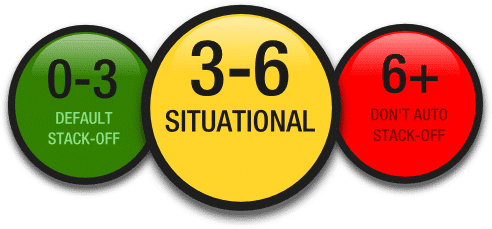In this episode, we’re going to talk about some questions you want to ask yourself and answer before you play a hand.
Before you enter a pot pre-flop, before you call, before you raise, you should be formulating a plan.
Think of it this way: If you can’t clearly explain why you played the hand in the first place, you shouldn’t be playing the hand in the first place.
Remember, in poker, if you make a poor decision early on, that can compound on future streets for big losses. Best check yourself before wreck your stack.
The five questions we propose in this episode can be quickly answered before a hand to ensure you have a plan of action that can be tweaked on each street.

1. What do you anticipate the other players will do?
Before a single card is dealt, you will know the position of each player at the table. If you’ve been paying attention, the longer you’ve been playing with them, the more you’ll be able to anticipate what they’re likely to do.
Be a proactive poker player. Far too many players struggle in this game because they are stuck in a reactive mode. They react to what other players are doing. They react to their hole cards and the board. They react to everything.
But the best players are extremely proactive and thinking ahead. You don’t have to be a strategic whiz to have a basic plan of attack, and a basic plan attack is far superior to no plan of attack. (Assuming it’s a good plan.)
Classic example. $1/$2 limp-fest, with lots of fishy passive players. If you raise, you’re likely to get a bunch of calls and go multiway. You should already be thinking about what you’ll do if someone donks into you, if it checks to you, what bet size you’ll make to continue, what you’ll do facing a 3bet.
This may sound like a lot to think about in the moment, and it is. But as you repeat the exercise, you’ll start to intuitively plan ahead based on common situations you encounter over and over.
2. What kind of hand do you have?
Too many people only focus on their two hole cards — so make sure you’re asking the other questions.
With that caveat, you obviously should be thinking about what kind of hand you have and how it tends to play.
Eventually, you will be thinking of your hole cards in terms of a part of a range of hands that you are representing at the table, but for starters, it’s enough to focus on your exact hand. Thinking ahead a few steps, how is the action likely to play out, given the players in the hand? How will it play out on a flop that’s good for your hand vs. a bad one?
An example would be pocket 3’s in middle position at a table full of 3-betting machines. Someone who doesn’t plan ahead might open the hand as a default without realizing the context is not favorable. SplitSuit gives a few more examples to illustrate.
3. Is this pot likely to go heads up, multiway, or will everyone fold?
In addition to asking yourself what each player is likely to do, think about the table dynamic as a whole. Have there been a lot of limped family pots? Have aggressive 3-bets been keeping the game moving with fewer flops than usual? Then think about your hand in that specific context.
Some hands in some positions play well in some contexts, and the inverse is certainly true as well.
SplitSuit gives several examples — such as broadway cards, which are nice heads-up but lose their luster in a multiway pot.
Don’t forget the “no-way” flop, where you have an opportunity to make a 3-bet, perhaps a light one, and the likelihood is that you’ll get the table to fold. When there are multiple nits at your table, this is a very profitable play and your cards don’t really matter. You can save a lot of money after the flop by predicting the likely outcome of the pre-flop betting round as well.
4. If you end up going to the flop, what is the SPR going to be?
Stack-to-pot ratio was made famous in the book Professional No-Limit Hold’Em: Volume 1, co-written by Red Chip coach Ed Miller.
If you don’t know what SPR is — in a nutshell, you divide the effective stack by the pot size on the flop. A very low SPR means you’re very committed to the pot, a very high SPR means you have more room to maneuver.
Let’s say your effective stack is $200 and there’s $50 in the pot on the flop. You have an SPR of 4. You are definitely on the brink of pot commitment, but you have a little wiggle room, as opposed to being on a short $100 stack when the pot is $80. In that case, your low SPR commits you to shoving the flop. However, if you had a big stack of $800 in a $80 pot, your SPR of 10 gives you all the opportunity in the world to make plays.
SplitSuit developed “SPR zones” to give you a rough sense of how your SPR number should affect your plan for the rest of the hand:

Thinking about stack depth and SPR of yourself and your opponents, and plan ahead carefully. Much of what’s to come can be predicted by quickly calculating SPR. Multiway pot? We’re usually looking at a smaller SPR. Is a 3-bet likely if you raise in early position? Are you ready to play a flop with an SPR that low if you call? As usual, SplitSuit has many examples.
5. What do you think is going to happen post-flop?
It might seem kind of complex to think of the turn and river starting before the flop, and that’s because it is. To plan out multiple branches of decisions across multiple streets with multiple players is something that doesn’t come easy. It comes with practice. Developing a chess-like mind for poker means extrapolating turns and rivers before those cards ever come.
For example, when you get raised out of position by a player pre-flop and call, what is their range, and what are they likely to do on the flop, turn and river with that kind of range? Can you exploit their fit-or-fold tendencies? Can you blast them off a premium pair if the turn or river is scary?
This kind of advanced thinking is required for advanced play. As you move up in levels, you’ll notice more and more players are dynamically creating and executing plans, from pre-flop to showdown. Having this level of thinking in a $1/$2 game, combined with the four previous questions, is going to allow you to dominate. Again, it takes practice to master, but it is within reach of any poker player that’s determined enough to ask these five questions before getting involved in any hand.
Even if a wrench gets thrown into your plan, at least you had a plan to begin with. That’s going to be an enormous edge as you hone it over the coming weeks, months and years.

I believe that Ed Miller is the best teacher for mid range players. His explanations are right on. Keep it coming Ed. BTG 805
Ed is awesome…but Ed isn’t on this podcast episode =)
excellent podcast, thank you. I have an example of a spot i think i misplayed. I am in the CO with A5s in a live 2-5 game my stack is 600 and everybody covers me, UTG+1 young aggressive raises to 20 MP3 Asian guy fairly tight calls, i 3bet to 70 another young aggressive guy flat calls on the BTN, the SB another young aggro kid, clearly a grinder (before you ask, yes i was actively looking for a table change 🙂 ) reraises to 240, it folds to me. I ended up folding because I was afraid to pull the trigger but I think the correct play is to shove. I will post this in the forum with the maths and analysis I looked at, I would appreciate a comment here or in the forum
Thanks Roberto! I’ll check out the hand in the forum.
Great advice delivered at lightning speed. Why not provide a podcast player on your web page with some controls like backing up or skipping forward? BYW, when I click on the Stitcher button to hopefully get these controls, I can’t find the podcast.
Again excellent advice thank you.
What was the date of this podcast? I’m looking for it in iTunes, but can’t find it.
iTunes only holds the most recent 100 podcasts. That one was from early 2016.